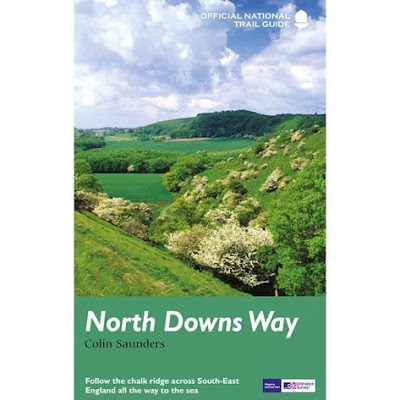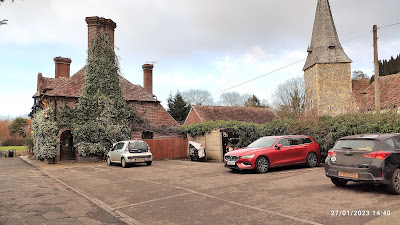A couple of posts ago, you may remember me saying that bad weather had forced me to postpone walking the remaining two miles of the official route of the North Downs Way. The idea was to try again in a few weeks’ time. Previously, I had travelled to the Three Horseshoes pub at Knockout Pound, by bus from Orpington station, but with a couple of rail strikes called for the end of the week, that means of reaching the pub was untenable. It was then that I had a brain wave, why not drive to Knockholt, and follow a circular route that involved the missed section of NDW, and then a return, along the road, to the Three Horseshoes. I knew my previous at this section that there was a pavement all the way to Knockholt Pound, so providing I could find a suitable spot to park my car, where it wouldn’t get hit or cause an obstruction, then it was game on. A few clicks on Google Street View, confirmed that the small area of green, opposite the pub, would be the ideal place to leave my vehicle, and so on Thursday morning, off I went. Half an hour later, I was pulling up opposite the Three Horseshoes, relieved to find my chosen spot was empty. I’d dressed slightly differently from my usual walking attire, especially with regard to my footwear. Rather than my tried and tested Meindl hiking boots, I wore an old pair of gardening shoes instead, as it stood to reason that heavy and rigid walking boots, would be unsafe to drive in. Also, I didn't fancy faffing about changing footwear, after parking the car, and then having to changed back again, on completion of the walk. Without giving too much away, I'm not as subtle, or indeed as flexible as I once was, and bending down in a confined space whilst attempting to tie intricate boot laces, was not a good idea. Fortunately, given nearly two weeks without any significant rainfall, the ground under foot was just right for the type of footwear I was wearing, and whilst there were still muddy patches in places, these were quite easy to avoid. There's not too much to say about the walk itself, apart from confirming involved a walk along Chevening Lane to the top of the escarpment, and then turning right, onto the footpath that is the North Downs Way. Most of the route followed the edge of several fields that skirted an area of dense woodland. At one point there was a narrow break in the trees, which afforded a keyhole view down towards Chevening House. This impressive retreat is the official residence of the British Foreign Secretary - whoever he or she might be, at the moment! Later on, the path veered to the right, again following the field boundary, before plunging into an area of woodland. this was the same wood where I became lost and diverted away from the official route, nearly two years ago. Fortunately, this didn't happen this time around, although it might well have been that the NDW direction signs were clearer, for those walking east to west, as last time I’d been walking in the opposite direction. Upon entering the wood, I stopped to take a few photos of the snowdrops which were quite prolific in certain areas. Their tiny while flowers contrasting against the carpet of dried leaves on the woodland floor. They looked lovely, and a real herald that spring might soon be on its way. Eventually I reached Sundridge Lane, where I turned right and followed the road to the T-junction at the end, where it joins with the aptly named Main Road that runs along towards Knockholt. Fortunately, the road has a pavement, so I followed it, in an easterly direction back towards where I had parked the car. I stopped on the way for a look at Vavasseurs Wood, on the opposite side of the road, as this small wooded area looked vaguely familiar. It was of course the place I had ended up in last time, when I stumbled out of the trees onto Main Road, almost by accident. I was obviously very disoriented, back then, but this time, and just 10 minutes later, I arrived back opposite the Three Horseshoes, where my car was waiting. I then set off to drive to the village of Cudham, the home of the mystery pub I referred to in that last January post. I claimed that it was the pub that most members of West Kent CAMRA would not have been to, although I obviously did them a disservice with that statement. Most of them are well travelled, and I know that two of them formerly lived in the Bromley-Orpington area, and would be pretty familiar with the surrounding villages. This was my first time in Cudham, which was further away from Knockholt, than I thought. It was a spread out and rather lengthy settlement of cottages, the odd farm house plus a number of large, well-to-do properties. It was all very rural in nature, so I was surprised to see a sign warning motorists that it lies in the recently expanded Ultra Low Emissions Zone (ULEZ), although not until August, as subsequent research revealed. I don’t want to get into the pros and cons of expanding this zone, but Cudham at least, along with the surrounding areas, seemed pretty rural to me. Local residents, with an older, and non-compliant vehicle, will have to pay a fee of £12.50 each day they take the car off the drive. One could perhaps understand this in a built-up area, but in the middle of the countryside? The Blacksmith's Arms, lies at the far end of the village, and is situated on high ground amid some attractive countryside. The pub's website details the history of the building, which stretches back to 1628 when a farm house and stables were erected. It became an alehouse in 1729 and was owned by a blacksmith's family business. An old photo inside the pub, shows that it formerly belonged to the Dartford Brewery, but in more recent times, it was a Courage house, as evidenced by the signage both externally, and internally, above the bar. I successfully negotiated the rather tight entrance to the rear car park and was surprised by the number of cars already there. I accessed the pub via the rear entrance and once inside, the number of customers explained the nearly full car park. I approached the bar but as I couldn't see around the corner where the hand pumps were, the girl behind the bar informed me that Doom Bar and Harvey's were the beers available. I naturally opted for the latter, and also asked about food. There was bit of a wait due to a large party of ramblers who’d arrived earlier, but as 15 minutes seemed quite reasonable, I went ahead and ordered a ham and mustard baguette. The pub extends quite a long way, to the left of the bar, into what appears to be almost a separate room, but I managed to find small vacant table in the corner, close to the fire. I sat down to enjoy my beer, pleased to see that the pub was so busy, in fact I’d say it was buzzing. The largely “senior” clientele seemed a similar age to myself, or perhaps slightly older. Judging by their footwear and back packs, quite a few were ramblers, and it was good to see they were responsible ones. I say that because last autumn, whilst out for my usual lunchtime walk, I witnessed a party of walkers, quite brazenly sitting in the, admittedly empty garden of the Little Brown Jug, eating their sandwiches and knocking back cups of tea from their Thermos flasks. A colleague noticed them too, and neither of us could believe the bare-faced cheek of this group! I didn't have to wait too long for my food, which for me was just the right portion for lunchtime. The baguette contained some nice thick slices of ham, although if I'm honest I could have done without the grated carrot and other fancy pieces of salad. There wasn't time for another pint, and I was driving anyway, but more importantly, I had to get back to collect Mrs PBT’s from the farm-based office, where she works, on Thursdays. Before returning to the car, I crossed the road in order to take some photos of the front of the pub. The aforementioned Courage sign was still proudly on display, adding a touch of nostalgia.
My route back to Tonbridge involved cutting across to Westerham Hill, before taking the northern relief road,
known as Beggars Lane, which bypasses the town. Westerham Brewery is off this lane,
but
with no time to stop, I was aiming for the A25, and then the A21. I arrived at Mabledon Farm with 5 minutes to spare, but then of course
Eileen wasn’t ready to leave! I was delighted to have experienced the busy and
buzzing Blacksmith’s Arms and can understand the reasons for its popularity. As
I said in a previous post, the Blacksmith’s Arms is reachable by bus, from
Orpington station, and that is the route by which I shall return next time I
decide to visit.

























